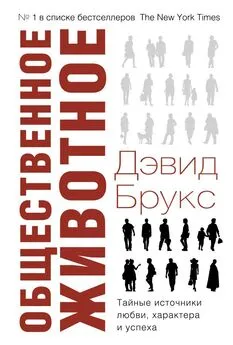Дэвид Брукс - Общественное животное. Тайные источники любви, характера и успеха
- Название:Общественное животное. Тайные источники любви, характера и успеха
- Автор:
- Жанр:
- Издательство:ACT
- Год:2013
- Город:Москва
- ISBN:978-5-17-080011-7
- Рейтинг:
- Избранное:Добавить в избранное
-
Отзывы:
-
Ваша оценка:
Дэвид Брукс - Общественное животное. Тайные источники любви, характера и успеха краткое содержание
Общественное животное. Тайные источники любви, характера и успеха - читать онлайн бесплатно полную версию (весь текст целиком)
Интервал:
Закладка:
252
John Medina, Brain Rules: 12 Principles for Surviving and Thriving at Work, Home, and School (Seattle, WA: Pear Press, 2008), 262.
253
Michael S. Gazzaniga, Human: The Science Behind What Makes Us Human (New York: Harper Perennial, 2008), 96.
254
Peter A. Hall and David W. Soskice, «An Introduction to the Varieties of Capitalism,» in Varieties of Capitalism: The Institutional Foundations of Comparative Advantage, eds. Peter A. Hall and David W. Soskice (Oxford: Oxford University Press, 2004), 1-70.
255
Arthur Robert Jensen, The G Factor: The Science of Mental Ability (Westport, CT: Praeger Publishers, 1998), 34-35.
256
Robin Karr-Morse and Meredith S. Wiley, Ghosts from the Nursery: Tracing the Roots of Violence (New York: Atlantic Monthly Press, 1997), 28.
257
Dean H. Hamer and Peter Copeland, Living with Our Genes: Why They Matter More Than You Think (New York: Anchor Books, 1999), 217.
258
Richard W. Nisbett, Intelligence and How to Get It: Why Schools and Cultures Count (New York: W W Norton & Co., Inc., 2009), 41.
259
Bruce E. Wexler, Brain and Culture: Neurobiology, Ideology, and Social Change (Cambridge, MA: MIT Press, 2006), 68.
260
Nisbett, 44.
261
James R. Flynn, What Is Intelligence?: Beyond the Flynn Effect (Cambridge: Cambridge University Press, 2007), 19.
262
David G. Myers, Intuition: Its Powers and Perils (New Haven, CT: Yale University Press, 2002), 35.
263
Richard К. Wagner, «Practical Intelligence,» in Handbook of Intelligence, ed. Robert J. Sternberg (Cambridge: Cambridge University Press, 2000), 382.
264
John D. Mayer, Peter Salovey and David Caruso, «Models of Emotional Intelligence,» in Handbook of Intelligence, ed. Robert J. Sternberg (Cambridge: Cambridge University Press, 2000), 403.
265
Nisbett, 18.
266
Daniel Goleman, «75 Years Later, Study Still Tracking Geniuses,» New York Times, March 7, 1995, and Richard C. Paddock, «The Secret IQ Diaries,» Los Angeles Times, July 30, 1995.
267
Malcolm Gladwell, Outliers: The Story of Success (New York: Little, Brown & Co., 2008) 81-83 (рус. изд. - Малкольм Гладуэлл. Гении и аутсайдеры. Почему одним все, а другим ничего? М.: Манн, Иванов и Фербер, 2013).
268
John Tierney, «Smart Doesn’t Equal Rich,» New York Times, April 25, 2007.
269
Keith E. Stanovich, What Intelligence Tests Miss: The Psychology of Rational Thought (New Haven, CT: Yale University Press, 2009), 31-32.
270
Jonah Lehrer, «Breaking Things Down to Particles Blinds Scientists to Big Picture,» Wired, April 19, 2010.
271
Stanovich, 34-35.
272
Stanovich, 60.
273
James J. Heckman and Yona Rubinstein, «The Importance of Noncognitive Skills: Lessons from the GED Testing Program,» in American Economic Review 91, no. 2 (May 2001): 145-49.
274
Robert Scott Root-Bernstein and Michele Root-Bernstein, Sparks of Genius: The Thirteen Thinking Tools of the World's Most Creative People (New York: First Mariner Books, 2001), 3.
275
Root-Bernstein and Root-Bernstein, 53-54.
276
Root-Bernstein and Root-Bernstein, 196.
277
«6 Ways Supermarkets Trick You to Spend More Money,» Shine, March 1, 2010.
278
Martin Lindstrom and Paco Underhill, Buyology: Truth and Lies About Why We Buy (New York: Doubleday, 2008), 148-49.
279
Joseph T. Hallinan, Why We Make Mistakes: How We Look Without Seeing, Forget Things in Seconds, and Are All Pretty Sure We Are Way Above Average (New York: Broadway Books, 2009), 92-93.
280
Расо Underhill, Call of the Mall: The Geography of Shopping by the Author of Why We Buy (New York: Simon & Schuster, 2004), 49-50.
281
Timothy D. Wilson, Strangers to Ourselves (Cambridge, MA: Belknap Press, 2002), 103.
282
Richard H. Thaler and Cass R. Sunstein, Nudge: Improving Decisions About Health, Wealth, and Happiness (Ann Arbor, MI: Caravan Books, 2008), 64.
283
Hallinan, 99.
284
David Brooks, «Castle in a Box,» The New Yorker, March 26, 2001.
285
Steven E. Landsburg, «The Theory of the Leisure Class,» Slate, March 9, 2007.
286
John Medina, Brain Rules: 12 Principles for Surviving and Thriving at Work, Home, and School (Seattle, WA: Pear Press, 2008), 163.
287
Jonah Lehrer, «The Truth about Grit,» Boston Globe, August 2, 2009.
288
Richard Bronk, The Romantic Economist: Imagination in Economics (Cambridge: Cambridge University Press, 2009), 17.
289
Predictably Irrational: The Hidden Forces That Shape Our Decisions (New York: HarperCollins, 2008), 243 (рус. изд. - Дэн Ариели. Поведенческая экономика. Почему люди ведут себя иррационально и как заработать на этом. М.: Манн, Иванов и Фербер, 2012).
290
Anemona Hartocollis, «Calorie Postings Don’t Change Habits, Study Finds,» New York Times, October 6. 2009.
291
Ariely, 170-71.
292
John A. Bargh, «Bypassing the Will; Toward Demystifying the Nonconcious Control of Social Behavior,» in The New Unconscious, eds. Ran R. Hassin, James S. Uleman, and John A. Bargh (Oxford: Oxford University Press), 40.
293
Claude M. Steele, «Thin Ice: Stereotype Threat and Black College Students,» The Atlantic, August 1999.
294
Margaret Shih, Todd L. Pittinsky, and Nalini Ambady, «Stereotype Susceptibility: Identity Salience and Shifts in Quantitative Performance, Psychological Science 10, no. 1 (January 1999): 80-83.
295
Hallinan, 102.
296
Robert E. Omstein, Multimind: A New Way of Looking at Human Behavior (New York: Houghton Mifflin, 1996), 86.
297
Dan Arieiy, «The Fallacy of Supply and Demand,» Huffington Post, March 20, 2008.
298
Hallinan, 50.
299
Jonah Lehrer, How We Decide (New York; Houghton Mifflin Co., 2009), 146.
300
Thaler and Sunstein, 34.
301
Hallinan, 101.
302
Ariely, 96 and 106.
303
Jonah Lehrer, «Loss Aversion,» The Frontal Cortex, February 10, 2010.
304
Oliver Burkerman, «This Column Will Change Your Life,» The Guardian, May 8, 2010.
305
«Pew Report on Community Satisfaction,» Pew Research Center (January 29, 2009): 10.
306
William A. Galston, «The Odyssey Years: The Changing 20s,» Brookings Institution, November 7, 2007.
307
William Galston, «The Changing 20s,» Brookings Institution, October 4,2007.
308
Robert Wuthnow. After the Baby Boomers: How Twenty- and Thirty-Somethings Are Shaping the Future of American Religion (Princeton, NJ: Princeton University Press, 2007), 29.
309
Jeffrey Jensen Arnett, Emerging Adulthood: The Winding Road from the Late Teens through the Twenties (Oxford: Oxford University Press, 2004), 16.
310
Jean Twenge, Generation Me: Why Today's Young Americans Are More Confident, Assertive, Entitled — and More Miserable Than Ever Before (New York: Free Press, 2006), 69.
311
Wuthnow, 62.
312
Wuthnow, 32.
313
Michael Barone, «А Tale of Two Nations,» US Hews & World Report, May 4, 2003.
314
Elizabeth Kolbert, «Everybody Have Fun,» The New Yorker, March 22, 2010.
315
Elizabeth Kolbert, «Everybody Have Fun.»
316
Derek Bok, The Politics of Happiness: What Government Can Learn from the New Research on Well-Being (Princeton, NJ: Princeton University Press, 2010), 13.
317
Bok, 17-18.
318
David Blanchflower and Andrew Oswald, «Well-Being Over Time in Britain and the USA,» Journal of Public Economics 88 (July 2004): 1359-86.
319
Robert D. Putnam, Bowling Alone: The Collapse and Revival of American Community (New York: Simon & Schuster, 2000), 333.
320
David Halpern, The Hidden Wealth of Nations (Cambridge: Polity Press, 2010), 26.
321
Tara Parker-Pope, «What Аге Friends For? A Longer Life,» New York Times, April 21, 2009.
322
Bok, 28.
323
Halpern, 28-29.
324
Roy E. Baumeister, The Cultural Animal: Human Nature, Meaning, and Social Life (Oxford: Oxford University Press, 2005), 109.
325
Joan Raymond, «He’s Not as Smart as He Thinks,» Newsweek, January 23, 2008.
326
Joan Raymond, «He’s Not as Smart as He Thinks.»
327
Lionel Trilling, Sincerity and Authenticity (Cambridge, MA: University of Harvard Press, 1972), 5.
328
Helen Fisher, Why We Love: The Nature and Chemistry of Romantic Love (New York: Henry Holt & Co., 2004), 1.
329
Kaja Perina, «Love’s Loopy Logic,» Psychology Today, January 1, 2007.
330
Fisher, 53.
331
Ayala Malakh Pines, Falling in Love: Why We Choose the Lovers We-Choose (New York: Routledge, 2005), 154.
332
Fisher, 69.
333
Sadie F. Dingfelder, «More Than a Feeling,» Monitor on Psychology 38, no. 2 (February 2007): 40.
334
Интервал:
Закладка:










